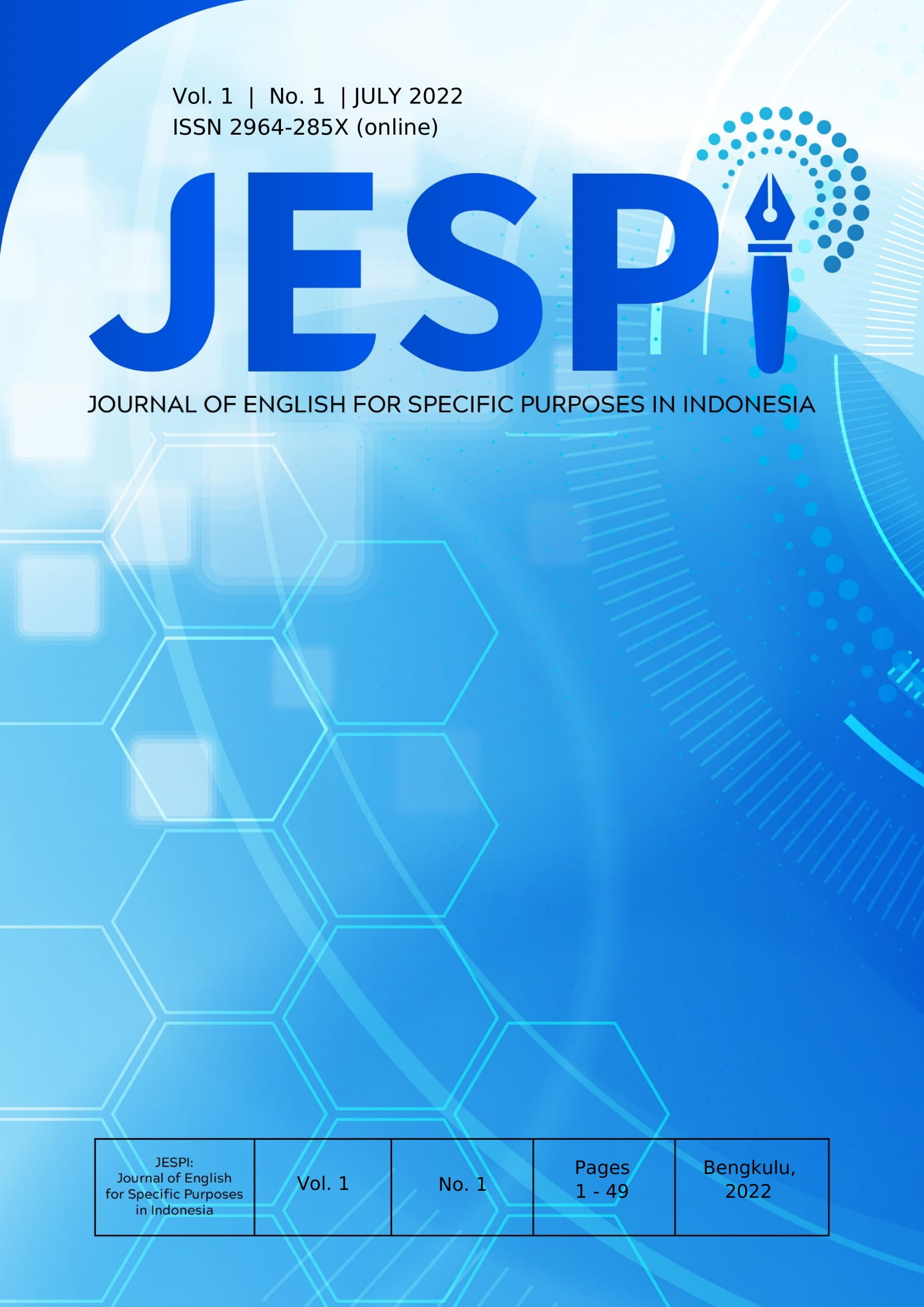Main Article Content
Abstract
The use of English seldom make students have a bad ability to speak and comprehend English as their teacher wants. It caused the students can not understand what their teacher has explained because they just have little vocabulary in English. Besides, the text in the students' book used foreign narratives, and foreign activities so that the students can not understand and comprehend the context of the book itself. Because of the condition, the teacher needs to approach to inform their students about English itself. That is why the sociolinguistic approach is needed in that condition because it can make students understand and comprehend easily the context of their English book. Therefore, this study is the gap to know teachers' perspectives on the use of the sociolinguistic approach in ELT and hindering that the teachers found in the implementation sociolinguistic approach. This study used descriptive qualitative research with 26 participants of English teachers. The findings of this study showed that sociolinguistics gave positive perspectives and benefits to the students.
Keywords
Article Details

This work is licensed under a Creative Commons Attribution-ShareAlike 4.0 International License.

Ciptaan disebarluaskan di bawah Lisensi Creative Commons Atribusi-BerbagiSerupa 4.0 Internasional.
References
- Cohen, L., et al. 2007, Research Methods in Education (6th ed), Routledge, London
- Cameron, L. (2001). Teaching Languages to Young Learners. Cambridge: Cambridge University Press
- Da Costa & Arias .(2021). Sociolinguistics Approaches in EFL Teaching Methods for Dominican College Students. Universidad Autónoma de Santo Domingo
- Davies, D. (2014). Varieties Of Modern English: An Introduction. In Varieties Of Modern English: An Introduction. https://doi.org/10.4324/9781315838861
- Fraenkel, Jack. R., and Norman E. Wallen. 2008. How to Design and Evaluate Research in Education 8th Edition. Boston: McGraw-Hill Higher Education.
- Guoxing, Y. (2004). Perception, practice, and progress: Significance of scaffolding and zone of proximal development for second or foreign language teachers. Asian EFL Journal, 6(4),24.
- Holmes, J. (2001). An introduction to sociolinguistics (2nd ed.). London: Longman.
- Holmes, J. (2013). An Introduction To Sociolinguistics. 4th Edition. In Pearson Education Limited. https://doi.org/10.1525/Jlin.2003.13.2.252
- Hudson, R. A. (1996). Sociolinguistics. Cambridge [England: Cambridge University Press. Chicago (Author-Date, 15th ed.)
- Leont’ev, A. N. (1981). The problem of activity in psychology. In J. Wertsch (Ed.), The concept of activity in Soviet psychology (pp. 37–71). Armonk, NY: M. E. Sharpe. Li, D. (1998). It's always more difficult than you plan and imagine: Teachers' perceived difficulties in introducing the communicative approach in South Korea. TESOL Quarterly, 32(4), 677-703.
- Maryam, 2006. Contrastive Pragmatic Study and Teaching Culture in English Language Classroom. University Sains Malaysia
- Mitchell, R., & Myles, F. (2004). Second language learning theories. London: Edward Arnold.
- Richards, J.C.(1985). The Context of Language Teaching. Cambridge: Cambridge University Press.
- Savignon, S. J. (2002). Communicative Language Teaching: Linguistic Theory And Classroom Practice (Chp 1). Interpreting Communicative Language Teaching: Contexts And Concerns In Teacher Education. https://doi.org/10.1017/S0272263104251051
- Saville-Troike, M. (2008). The Ethnography Of Communication: An Introduction: Third Edition. In The Ethnography Of Communication: An Introduction: Third Edition. https://doi.org/10.1002/9780470758373
- Saville-Troike, M. (2009). The Ethnography Of Communication. In Sociolinguistics And Language Teaching. https://doi.org/10.1017/Cbo9780511551185.017
- Street, B., & Leung, C. (2010). Sociolinguistics, Language Teaching And New Literacy Studies. In Sociolinguistics And Language Education. https://doi.org/10.21832/9781847692849-013
- Susanto, 2007. Sosio Linguistics. Tulungung, Department of Education State Islamic College (STAIN) of Tulungagung
- Sugiyono. 2010. Metode Penelitian Kuantitatif, Kualitatif dan R & D. Bandung: Alfabeta
- Spolsky, B (2010). Sociolinguistic. Oxford University
- Vygotsky, L. S. (1978). Mind in society: The development of higher psychological processes. Cambridge, MA: Harvard University Press.
- Wardhaugh, R. (2006). An Introduction To Sociolinguistics Fifth Edition. In Blackwell Publishing
References
Cohen, L., et al. 2007, Research Methods in Education (6th ed), Routledge, London
Cameron, L. (2001). Teaching Languages to Young Learners. Cambridge: Cambridge University Press
Da Costa & Arias .(2021). Sociolinguistics Approaches in EFL Teaching Methods for Dominican College Students. Universidad Autónoma de Santo Domingo
Davies, D. (2014). Varieties Of Modern English: An Introduction. In Varieties Of Modern English: An Introduction. https://doi.org/10.4324/9781315838861
Fraenkel, Jack. R., and Norman E. Wallen. 2008. How to Design and Evaluate Research in Education 8th Edition. Boston: McGraw-Hill Higher Education.
Guoxing, Y. (2004). Perception, practice, and progress: Significance of scaffolding and zone of proximal development for second or foreign language teachers. Asian EFL Journal, 6(4),24.
Holmes, J. (2001). An introduction to sociolinguistics (2nd ed.). London: Longman.
Holmes, J. (2013). An Introduction To Sociolinguistics. 4th Edition. In Pearson Education Limited. https://doi.org/10.1525/Jlin.2003.13.2.252
Hudson, R. A. (1996). Sociolinguistics. Cambridge [England: Cambridge University Press. Chicago (Author-Date, 15th ed.)
Leont’ev, A. N. (1981). The problem of activity in psychology. In J. Wertsch (Ed.), The concept of activity in Soviet psychology (pp. 37–71). Armonk, NY: M. E. Sharpe. Li, D. (1998). It's always more difficult than you plan and imagine: Teachers' perceived difficulties in introducing the communicative approach in South Korea. TESOL Quarterly, 32(4), 677-703.
Maryam, 2006. Contrastive Pragmatic Study and Teaching Culture in English Language Classroom. University Sains Malaysia
Mitchell, R., & Myles, F. (2004). Second language learning theories. London: Edward Arnold.
Richards, J.C.(1985). The Context of Language Teaching. Cambridge: Cambridge University Press.
Savignon, S. J. (2002). Communicative Language Teaching: Linguistic Theory And Classroom Practice (Chp 1). Interpreting Communicative Language Teaching: Contexts And Concerns In Teacher Education. https://doi.org/10.1017/S0272263104251051
Saville-Troike, M. (2008). The Ethnography Of Communication: An Introduction: Third Edition. In The Ethnography Of Communication: An Introduction: Third Edition. https://doi.org/10.1002/9780470758373
Saville-Troike, M. (2009). The Ethnography Of Communication. In Sociolinguistics And Language Teaching. https://doi.org/10.1017/Cbo9780511551185.017
Street, B., & Leung, C. (2010). Sociolinguistics, Language Teaching And New Literacy Studies. In Sociolinguistics And Language Education. https://doi.org/10.21832/9781847692849-013
Susanto, 2007. Sosio Linguistics. Tulungung, Department of Education State Islamic College (STAIN) of Tulungagung
Sugiyono. 2010. Metode Penelitian Kuantitatif, Kualitatif dan R & D. Bandung: Alfabeta
Spolsky, B (2010). Sociolinguistic. Oxford University
Vygotsky, L. S. (1978). Mind in society: The development of higher psychological processes. Cambridge, MA: Harvard University Press.
Wardhaugh, R. (2006). An Introduction To Sociolinguistics Fifth Edition. In Blackwell Publishing
